
27 Nov Trafficking market goes wild in Vietnam
Oxpeckers’ Chinese Associate Hongqiao Liu discovers how easy it is to smuggle illegal wildlife products through China’s porous border with Vietnam – where trafficking on an industrial scale happens openly

Retail stores with wildlife products showcased on glass shelves are waiting for Chinese customers
Investigation shows that Vietnam, the biggest rhino horn-consuming country and a leading ivory transit country, is radically expanding its domestic wildlife trafficking business.
A wide range of endangered wildlife products are openly manufactured, showcased and traded in wildlife markets near its capital city, Hanoi, an undercover investigation by Oxpeckers discovered.
Following word-of-mouth information, we visited the wildlife markets in Vietnam and traced them back to upstream suppliers and downstream distributors.
We identified three major villages around Hanoi where illicit wildlife products are traded, processed, manufactured and transported to China and Thailand. A showroom for smuggled antique ivory products was also spotted in the heart of Hanoi city.
In northern Vietnam, a sophisticated network for wildlife crime has been set up involving Chinese-speaking tourist guides, professional middlemen, opportunistic retailers, deep-pocketed wholesalers, desperate smugglers and legally operating transnational logistics companies.
Surprisingly, in Vietnam, all these activities operate out in the open, like nothing is illegal.
Handicraft market
Want to buy some “distinctive” handicraft souvenirs made in Vietnam but don’t know where to go? No worry. Just walk into any of the travel agencies in the old district in central Hanoi, and friendly staff will tell you the place – Nhi Ke village.
Located 17km south of Hanoi, it’s easy for visitors to grab a taxi to Nhi Ke. The village is a small and crowded commune surrounded by vast expanses of paddy fields.
In the centre of the village, up to 30 retail stores with wildlife products showcased on glass shelves are waiting for Chinese customers. All the stores are distributed along two major shopping streets, crossed in a T-shape, with three landmark memorial temples sited among them.
An online search shows Nhi Ke is widely known for its rosewood carving tradition. Though timber handicrafts are also sold in the shops, most retailers choose to save the best display space for wildlife products made from ivory and rhino horn.
The village is like a museum of endangered wildlife products: piles of raw elephant tusks huddle in a corner while hawksbill turtle specimens decorate a wall; in a glass cabinet, tiger teeth, lion claws, leopard heads and tortoiseshell spectacle frames are also on display.
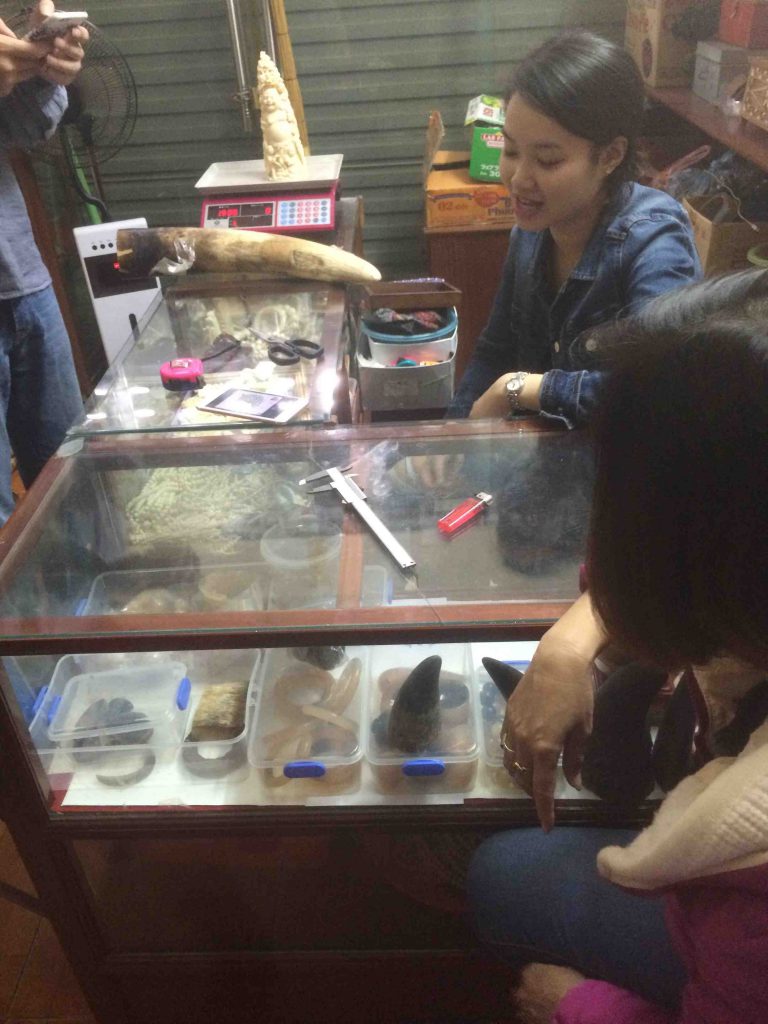
Rhino horns and ivory on display
Among all the wildlife species, elephant ivory is definitely the theme of the street. Walking along the shopping street, we were warmly offered countless ivory bracelets, beads, necklaces, rings, chopsticks, toothpicks, pipes, fountain pens and beautifully designed Buddha figurines.
South Africa’s dead rhinos also find their way here, their horns crafted into drinking cups, beads, rings and Buddha figurines, all carefully preserved in containers and impregnated with vegetable oil.
No matter what wildlife species are sold, each store is equipped with four basic tools: a calculator – for counting and bargaining; an electronic scale – to weigh the artwork; a steel ruler – for measuring length or thickness; and an electric torch, which can be replaced by the torchlight from a smartphone – to distinguish real from fake items, and to examine the quality of ivory.
Products are sold by size, weight, quality and design. For ivory handicrafts, the average retail price is VN$55,000 per gram (roughly US$2.58). Whole tusks are cheaper, ranging from VN$18-million to VN$22-million (roughly US$845 to US$1,032) per kilogram.
Rhino horn artworks are much more expensive. The retail price ranges from VN$350,000 to VN$650,000 per gram (roughly US$16.5 to US$30.6).
Visitors can buy a polished ivory bracelet from the market for US$150 to US$200, while a chain of beads polished from rhino horn can cost up to US$3,000.
The retailers are targeting customers from a wide range of classes. Bulk-production items like ivory bracelets or chopsticks are prepared for mass customers, while Buddha figurines crafted from ivory and rhino horn artworks are for collectors, businessman and bribers.
Ivory factories
The quantity of ivory products is astonishing. During our second visit to a handicraft store, a shopkeeper pulled out a suitcase and opened her safe, allowing us to choose the most stylish handicraft artworks. In this store alone, we saw at least 100 pieces of engraved Buddha figurines, a Vajra pestle, a scepter and elegant goodness sculptures in Chinese and Thai style.
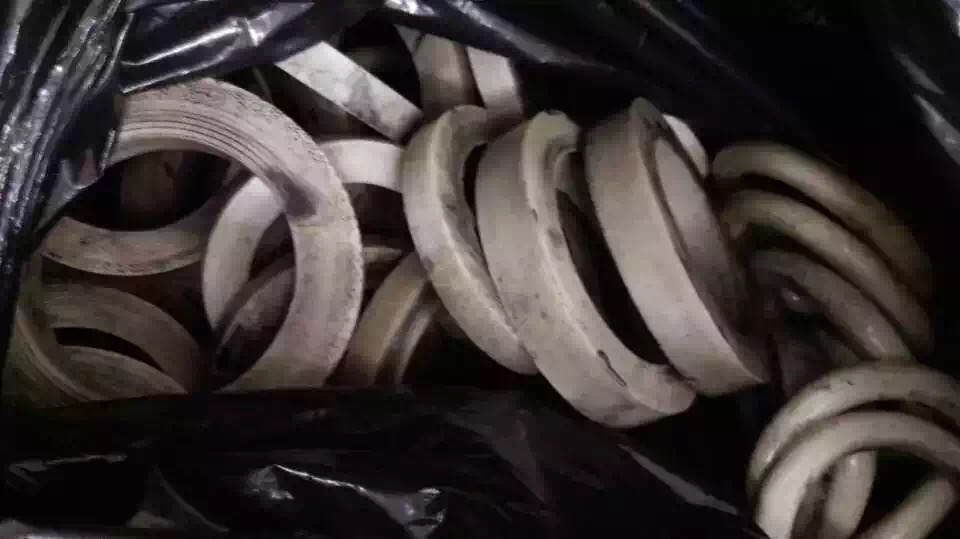
Shopkeepers take out large black plastic bags, full of ivory bracelets, from the bottom of the cabinet or from the back of the store
It happens in every store. Once you show interest in the higher-value handicraft, shopkeepers welcome you to the back of the store. Sitting on a bamboo mat, they will bring you their best collection of artworks. Not satisfied? Ask for more, they will bring you bags of products till you find the perfect piece.
We weighed some tusks and artworks, but it’s impossible to count how many ivory products are sold there. What’s for sure is that those on display are only the tip of the iceberg.
When asked for better quality products, shopkeepers always take out large black plastic bags – full of ivory bracelets or bead necklaces – from the bottom of the cabinet or from the back of the store.
The Chinese consumers
Walking through the streets, Chinese visitors can pick up their mother tongue everywhere. Chinese is not only used as a bargaining language between dealers and consumers, but is also printed on signboards of many shops.
One shop located in the middle of the shopping street, for example, boasts “Top Grade Ivory and Yellow Pear Handicraft Works Are Sold Here” on its board in Chinese and Vietnamese.
In the store next to it, we were greeted in standard Mandarin: “We only sell real ivory. All are real ivory. Good quality,” said a female shopkeeper in her late teens. She couldn’t communicate in Chinese, but had been trained to speak that sentence in Chinese, reflecting the primary concern for Chinese consumers.
Serious buyers can always hire a guide or a translator from Vietnam – normally Chinese-speaking Vietnamese, who often come from Dong Ky village, another traditional handicraft village located about 25km northeast of Hanoi.
The two villages are closely bonded together in facilitating wildlife trade. Both enjoyed well-known reputations for their wood-carving traditions historically.
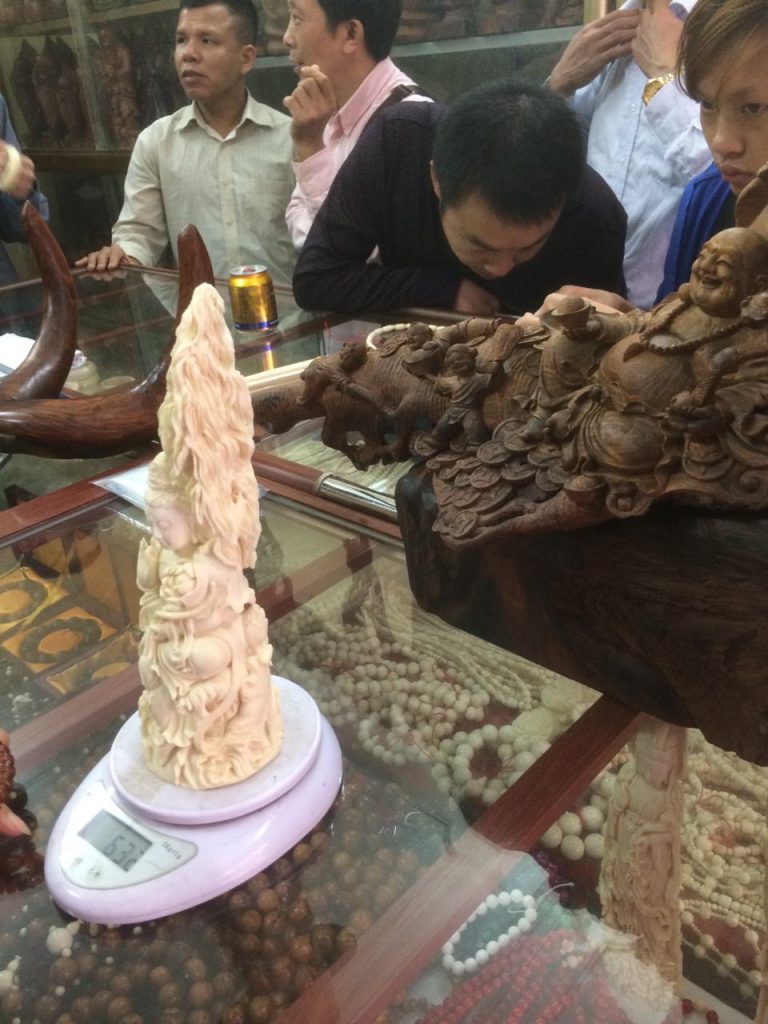
During our numerous visits to the markets, we came across groups of Chinese consumers each time – some in the company of Vietnamese guides, some on their own
In the past decade, Dong Ky village has grown to become the key trade hub for rosewood furniture in north Vietnam, while in Nhi Ke the craftsmen decided to apply their wood carving skills to more valuable materials – elephant tusks, and in very recent years, rhino horn.
During our numerous visits to the markets, we came across groups of Chinese consumers each time – some in the company of Vietnamese guides, some on their own.
In some shops, shopkeepers speak fluent Mandarin Chinese, making it convenient to bargain. The village is open for anyone to visit but no “Western faces” showed up during our visits.
We talked to the Chinese consumers doing their purchases.
“There is no danger in bringing ivory bracelets back to China. You can wear it when you cross the customs. No one will ask you about it,” said a Chinese buyer, who operates a timber business in Dong Ky. According to him, it’s easier to carry small pieces back to China by train than by bus because there is less chance of detection.
Most Chinese consumers we met only showed interest in small pieces of ivory products like bracelets. They didn’t dare to take the risk of bringing a large piece of ivory back to China.
“I don’t want to get into trouble. It’s illegal,” said a Chinese buyer from Shanghai. He walked in and out of several shops, and purchased a dozen bracelets and necklaces for his family and friends.
Where there is the need, there is the deed: there will always be someone ready to take the risk of shipping the large pieces of ivory or products back to China if a consumer won’t do it. For that reason, some shops provide additional customs and mailing services.
Customers can pick up a raw tusk and choose a pattern – an Avalokitesvara or Maitreya Buddha, tall or short, hollow or solid – then pay a 30% deposit. Within a month, the carving will be done.
With an additional mailing service fee, ranging from VN$1-million to VN$3-million per kilogram (roughly US$47 to US$140), the shop will send the product through the border and ensure it arrives safely in a border village on the Chinese side.
If it is not seized when crossing the border, which is often the case, the consumer then pays off the remainder through online transfer. Later, the consumer receives the product via mail or in person.
Nguyen Van Phuc Toi, a shop owner, said in the case of seizure, he promises to send a new item to China, on the house.
The manufacturers
While most shops in Nhi Ke open their doors for visitors, one particular shop – the largest retail shop and a major manufacturer in the village – operates its business behind closed doors.
Tourists can easily miss the three-floor building with its storefront shut, even though it has a signboard with images of wood handicrafts and ivory products. For ambitious buyers, this is the shop to visit.
Guided by a middleman, we walked into the yard through a narrow gate. After a few turns, we were led to the back of the storerooms. A young man wearing a Polo shirt opened the door.
Behind the rolling door is a totally different world to that in front.
Inside, there is a complete collection of raw elephant tusks, whole rhino horns, handicraft ivory products, rosewood carvings, big cat skeletons. Hundreds of pieces of wildlife products are heaped in the narrow room – so crowded that we could hardly find a space to stand.
“Don’t worry. You can step on that [tusks]. They won’t break,” said the young man.
Outside the showroom, more than 20 uncut raw elephant tusks were placed on the floor. Beside that, there was a pan scale. A young girl wearing heavy makeup encouraged us to lift the tusks to feel the weight.
I picked up a relatively short tusk on the top, an estimated 1.5m long. I tried to take a photo while holding the tusk in my other hand but couldn’t, it was too heavy.
On the second and third floors, the shop operates its manufacturing workshops. Raw tusks are weighed downstairs and then sliced into several pieces for further processing upstairs.
No part of the tusks will be wasted, considering their high value. The solid tip is the most expensive bit because it is ideal material for handicraft. The middle section is normally split into 2cm-thick slices for working into small pieces like bracelets, beads and seals.
The root end is the cheapest part of the tusk. However, in the hands of exquisite workmanship, it can be carved into pots, toothpicks, or even hollowed decorations.
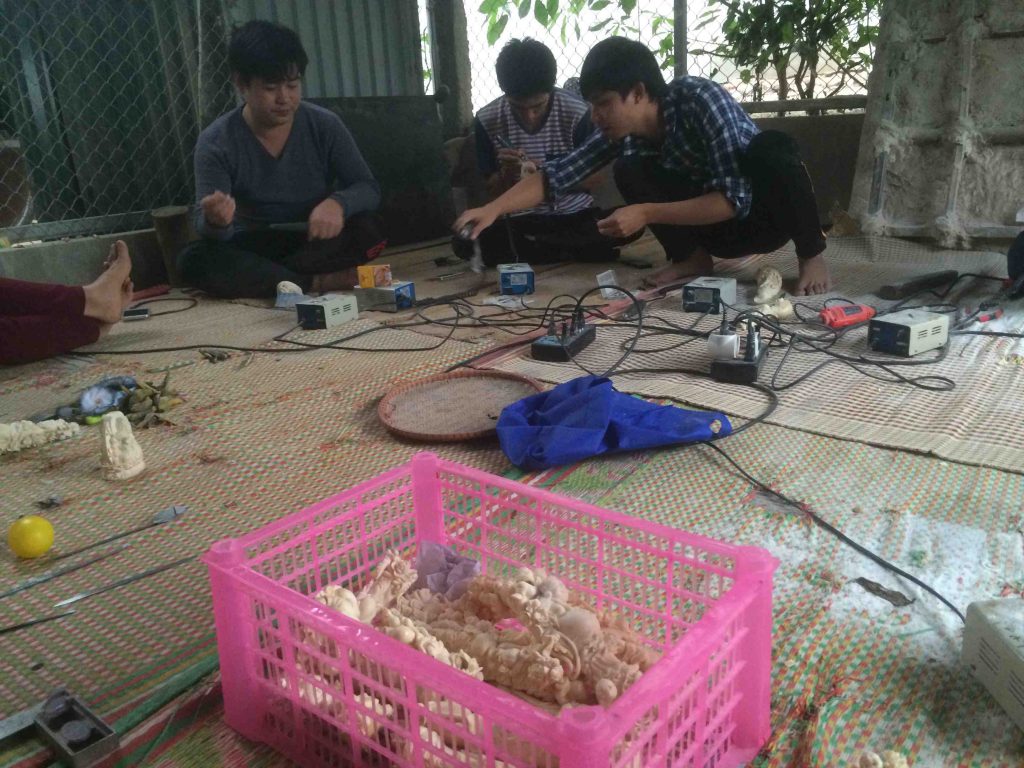
Inside the largest retail shop – a major manufacturer where there is a huge collection of raw elephant tusks, whole rhino horns, handicraft ivory products, rosewood carvings, big cat skeletons
Thuy Ung
A few kilometres south, there are more workshops in Thuy Ung village, another traditional handicraft village honoured by the Vietnamese government for its remarkable horn carving tradition.
While their ancestors did their carving with water buffalo horns, the young generation carries the tradition forward using more precious rosewood and elephant tusks.
We visited a supplier’s handicraft workshop in the village. Located in a narrow alley, the workshop is a semi-open space covered by a bamboo curtain.
A bamboo mat stretched out in the middle of a concrete cell. On the mat, six young engravers – all in their early 20s – sat in a circle, busy drilling out the details of semi-finished Buddha sculptures with electric drills.
At arm’s length, there was a pink plastic basket full of semi-finished ivory artworks. The engravers work from day to night to meet the demand. A bulb hung above them – lighting for the night-time work.
Manh Chien, in his early 30s, is in charge of the craft team. “I teach them how to make an art. Normally I do the design based on the shape of the tusk tip and set the design of the sculpture. Then I draw the outline – they pick up from there,” he said.
Manh Chien only stepped into the ivory business very recently. Before that, he was a creative sculptor who generally worked on rosewood and stone.
Unlike the other ivory craftsmen in Vietnam, who normally learn from apprenticeship, Manh Chien has a sound educational background and graduated from the country’s leading art college. That explains the exquisitely comprehensive artistic level of the carving pieces produced from his workshop – they are of a standard with the ivory artworks produced by Chinese folk craftsmen.
More surprisingly, Manh Chien said he had grasped the skill of engraving multi-layered hollowed ivory balls, which is supposed to be an exclusive handicraft skill in China. We were unable to evaluate his engraving skills, however, since he had no finished products at hand.
Another middleman showed me photos of advanced handicraft artworks combining ivory and rosewood root carvings in one piece of a Buddha sculpture. This was one of the indications that the craftsmen in Vietnam are introducing more and more creative ivory products in the market, including a dildo made from ivory.

Changes in ivory trafficking routes from 2000-2013, according to data from ETIS
The smuggling routes
Where are the elephant tusks in Vietnam coming from? According to various monitoring reports, most tusks in Vietnam are from African elephants, with a small amount of Asian elephant tusks. Mammoth tusks are also imported by the country.
According to the Elephant Trade Information System (ETIS), analysis of ivory trafficking seizures from 2000 to 2015 shows global ivory trafficking normally follows similar routes: tusks are shipped or flown from source countries in Africa to transfer countries in Southeast Asia or in Europe, and then are moved to end market countries such as China, Japan and Thailand.
Wildlife trade monitoring network Traffic identified Vietnam as a suspected “backdoor” transit route for consignments of ivory to China in 2009.
Five years later, in a paper submitted to the secretariat of the Convention in International Trade in Endangered Species (Cites), ETIS upgraded its evaluation of Vietnam – together with China, Kenya, Malaysia, the Philippines, Thailand, Uganda and Tanzania, Vietnam was identified as one of the eight countries of “primary concern” in terms of trade routes and transit countries or territories through which large quantities of ivory are flowing from Africa to Asian consumers.
Over the past decade, Vietnam has gradually built up its notorious reputation in various transnational wildlife crimes. Rhino poaching and trafficking, in particular, are primarily driven by domestic demand from Vietnam.
“Vietnam is playing an increasingly important role in the illegal wildlife and timber trade both as a demand country as well as a transit route to China,” said Vicky Lee, an analyst from the London-based Environmental Investigation Agency. In its 2014 report on ivory trafficking from Tanzania, the NGO ranked Hai Phong harbour in northern Vietnam alongside Hong Kong as a key transit route from Tanzania to mainland China.
Lying on the easternmost edge of Indochina Peninsula, Vietnam’s unique geographical location makes it in an ideal place for trafficking. Its long border lines with Laos, Cambodia and China mean wildlife products can be easily moved from its neighbouring countries, Laos and Cambodia – also transfer countries in the ivory trade – to China, the largest ivory consuming country in the world, and to Thailand, the other major market for ivory.
Vietnam’s 3,444km coastline has many excellent harbours. Illicit wildlife products from Malaysia and Indonesia, previously identified as the major transfer routes for the ivory trade from Africa to Southeast Asia, are also shipped via Vietnam.
Oxpeckers’ investigation identified several trafficking routes from Vietnam to China.
Individual tourists have a flexible trafficking route back to China. Trains and buses operate daily from Hanoi to Pingxiang, the border city on the Chinese side, or to Nanning, the capital city of Guangxi province, which shares a common border with northern Vietnam. Flights also operate daily from Hanoi to major cities in China – Beijing, Shanghai, Guangzhou, Nanning, etc.
During the field investigation, we were told by Chinese consumers who had successfully carried ivory products back to China that customs officers from both Vietnam and China would not bother to check small wildlife pieces like bracelets. That’s what I experienced when passing through customs.
Professional smugglers use different routes. International mailing services and physical distribution companies are commonly used to shift large quantity of tusks, and in some cases smugglers carry the products across the borderline by motorcycle, boat, or on foot.
The changing landscape
The landscape of wildlife crime in Vietnam is changing rapidly. After years of unregulated trade, the country is on a transition towards becoming a manufacturing hub for wildlife products.
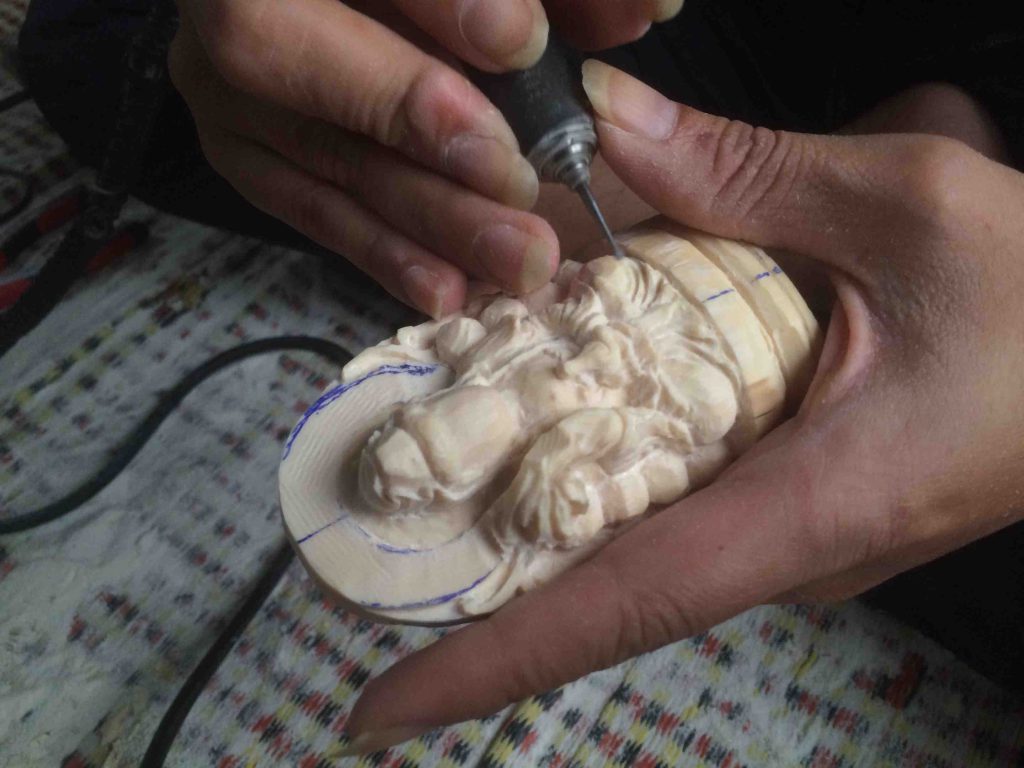
The new trading model indicates that demand for sophisticated ivory artworks is shifting to Vietnam
In light of the lack of law enforcement, the increased manufacturing capacity and upgraded handicraft skills in Vietnam could result in a difficult situation for cracking down on wildlife markets in Southeast Asia and East Asia, particularly for ivory products.
Tusks smuggled from Africa or transferred via Malaysia are being processed in Vietnam, from where Chinese consumers and Vietnamese dealers can trade openly.
The new trading model – pay a deposit first and receive the finished product at home – indicates that Chinese demand for sophisticated ivory artworks is shifting to Vietnamese producers.
Surprisingly, it seems no international conservation organisations have released any market monitoring reports on the openly operating wildlife markets in Vietnam. According to one conservationist in Vietnam, this may be because the trade is so open and so common that no one takes it seriously.
Education for Nature, a respected conservation organisation in Vietnam, plans to launch a new “consumer crime” campaign in Nhi Ke village. The organisation has had success in reducing the demand from Korean tourists for bear gall in Vietnam, and is confident it will work out a realistic strategy for reducing ivory demand in the village.
According to Tom Milliken, the director of the global elephant and rhino project at TRAFFIC International, previous analysis had found processing and end-use trade going on in Vietnam, but it had been rated as less than the raw ivory transit trade going directly to China.
However, in response to the Oxpeckers’ first-hand investigation in Vietnam, Milliken raised the possibility of reassignment – Vietnam may be viewed from now on as both a transit country and an end-use market.
“Indeed, the end-use market could intensify if we are successful in curtailing the illegal market in Thailand,” Milliken said.
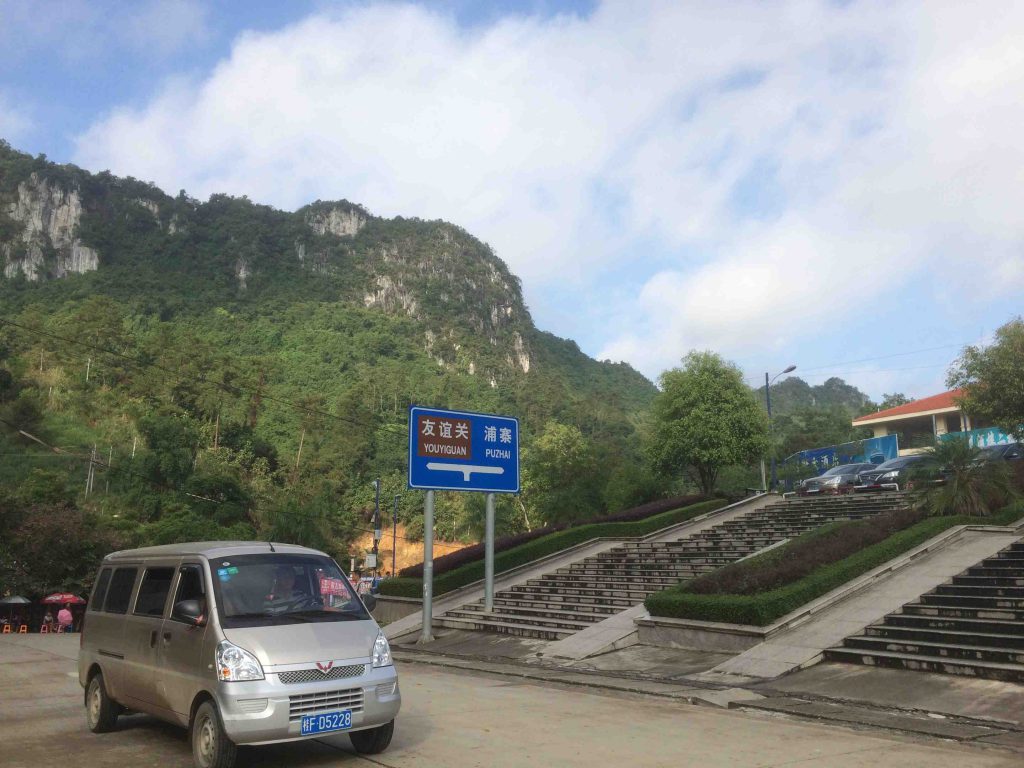
To test law enforcement along the border line, I took fake rhino horn and ivory through the major customs point, Youyi Guan
Vietnam to China: the missing link
To test law enforcement along the border line, in middle November I took a fake rhino horn – 20cm long, reshaped from water buffalo horn – in my bag, and wore a fake ivory bracelet made from plastic on my left hand when passing through the major customs point, Youyi Guan.
My bag was scanned twice when stepping out of the Vietnam border and entering the China border, but no one asked anything about the suspicious wildlife products.
I also took the fake horn and bracelet in my carry-on luggage when flying from Nanning city to Beijing. My bag passed the X-ray check without any questions.
During both the land and airport security checks, no one raised concerns about my fake horn which was shaped in the outline of a real rhino horn.
In the border city of Pingxiang in China, we talked to a political instructor from the local Forestry Public Security Station, the law enforcement branch of the State Forestry Bureau in China.
In his office hangs a large administrative map. In the middle point of the border line is Youyi Guan, the major border gate between the two countries. From there, the border line extends all the way up to the north as well as the east.
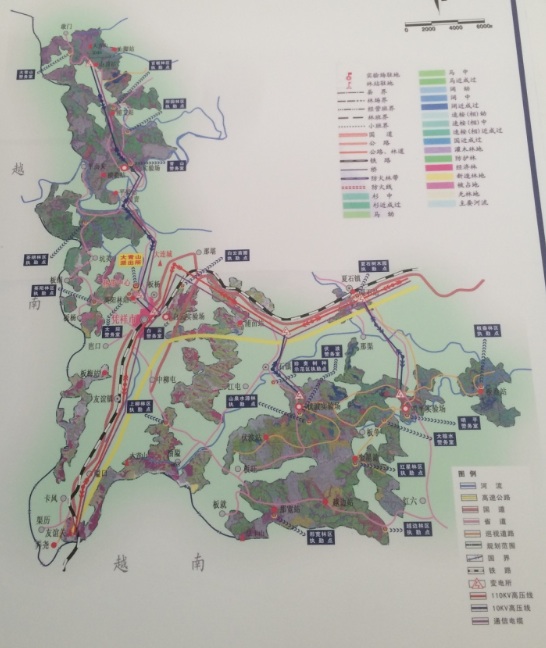
There are just 17 people working in 16 observation stations along the border line
The border area is covered by high mountains and lofty hills, with many small settlements dotted along the line. For Pingxiang city alone, the border line is up to 100km long.
“It’s our duty to crack down on illicit activities in our administrative forestry areas – that’s 28.5 square kilometres,” said the officer.
According to him, there are just 17 people working in 16 observation stations along the border line. For them, wildlife crime is only a minor task among many important ones.
Theoretically, all cargo and luggage should be examined before entering China, but sources from local law enforcement authorities said this only happens to about 5% of cargo. Considering the vast scale of cross-border trade, it’s not possible to check every piece of cargo or luggage.
Vietnamese migrants and labour forces travel across the border line daily, and many work illegally in China in the daytime and travel back at night without crossing through customs.
“There are countless mountain paths though the forests along the border line. Some even drive motorcycles through. It’s just too difficult for us to monitor all activities there,” said the official source, who asked not to be named for safety reasons.
Apart from Pingxiang city, which is well-known in China as the first gateway to Vietnam and its booming rosewood trade, on the eastern border, Dongxing city, a subsidy of Fangchenggang city, also emerges as a major trafficking destination on the border line.
Unlike the mountainous Pingxiang city, Dongxing is located on a coastal plain with many small streams and rivers flowing along the border line. It’s even easier to move wildlife products there. In some cases, bamboo rafts and speedboats are used as smuggling transport, according to the official source.
In April 2014, a smuggling group was seized in Tianjin and six pieces of ivory, weighing 17.185kg, was seized, in addition to 20 endangered big cat skeletons. Subsequent investigations revealed the smugglers had picked up the wildlife products on the highway near Dongxing city.
Some traders are more brazen. At this year’s China-ASEAN Exposition, held in Nanning city in September, a joint law enforcement team arrested two Vietnamese exhibitors who were openly selling illegal ivory products in the exhibition center.
“There is no firewall between the two countries, no joint law enforcement either, putting us in a passive situation in stopping transnational wildlife trafficking,” complained a high-level official in the provincial forestry department of Guangxi.
“The Vietnam government says they are strengthening legislation and making penalties more stringent, but so far nothing has been delivered in concrete terms. They need to be held accountable,” said Milliken.
Douglas Hendrie, wildlife crime and investigations unit advisor at ENV in Vietnam, has a more positive opinion, however.
“Ten years ago, there was no high-level political commitment and cooperation across multi-departments like today. The central government has moved in, so will local authorities, but changes can’t happen in one night,” said Douglas.
© Text and photos by Hongqiao Liu
Related links:
• Vietnam warning follows Oxpeckers exposé
• Who are Namibia’s Chinese smugglers?
• How cattle and mining interests are killing off Nambia’s black rhinos
• Namibia needs China’s help to curb poaching
• Inner workings of a Chinese poaching syndicate
